Cultivated Land Fragmentation and Its Influencing Factors Detection: A Case Study in Huaihe River Basin, China
Abstract
:1. Introduction
- (1)
- The degree of CLF and the balance of the spatiotemporal distribution of cultivated land resources in the Huaihe River Basin from 2000 to 2018 were measured by the entropy method and Lorentz curve method.
- (2)
- The spatial auto-correlation method was introduced to detect the spatial clustering characteristics of high and low values of CLF change in county units.
- (3)
- In cooperation with the geographical detector, the influencing factors of spatiotemporal differentiation of CLF were explored.
2. Materials and Methods
2.1. Study Area
2.2. Data Sources
2.3. Method
2.3.1. Lorentz Curve
2.3.2. Cultivated Land Fragmentation Index Selection
2.3.3. Measurement of Cultivated Land Fragmentation
- (1)
- Data standardization
- (2)
- Calculation of the standardized value Pij of indicator j in the year i:
- (3)
- Calculation of the entropy value ej of indicator j:
- (4)
- Calculation of weight Wj of indicator j:
- (5)
- Calculation of composite scores:
2.3.4. Spatial Autocorrelation
2.3.5. Geographical Detector
3. Results
3.1. Spatiotemporal Distribution Characteristics of Cultivated Land
3.1.1. General Pattern of the Spatiotemporal Distribution
3.1.2. Balance of Spatiotemporal Distribution
3.2. Spatiotemporal Distribution of Cultivated Land Fragmentation
3.2.1. Spatiotemporal Distribution of the Cultivated Land Fragmentation Index
3.2.2. Spatiotemporal Distribution Characteristics of Comprehensive Index of Cultivated Land Fragmentation
3.3. Correlation Analysis of Spatial Distribution of Cultivated Land Fragmentation
3.4. Influencing Factors of Cultivated Land Fragmentation
4. Discussion
4.1. Comparing with Previous Studies
4.2. Policy Implications
- (1)
- Strictly control the occupation of cultivated land by construction land in the basin, earnestly implement the policy of requisition-compensation balance [57], strictly observe the red line of cultivated land protection, ensure the efficient utilization of cultivated land resources in the Huaihe River Basin, guarantee food security, and stabilize the position of the grain production base in the basin.
- (2)
- On the basis of protecting the ecological environment, implement differentiated conversion of cultivated land to avoid unreasonable conversion and excessive greening of cultivated land, and reduce the degree of dispersion of cultivated land patches.
- (3)
- Formulate reasonable land use planning, realize the optimization of land use structure, take the Huaihe River as the boundary, adjust paddy field and dry land differently, implement a reasonable dry land conversion project, and avoid blindly pursuing high-income land use transformation.
- (4)
- Leverage the advantages of extensive natural geography in the eastern and southern plain of the Huaihe River Basin, strengthen the support for large-scale agricultural industry management, reduce the phenomenon of land fragmentation management in the plain by support and encouragement, and improve the utilization efficiency of cultivated land resources.
4.3. Limitations and Future Directions
5. Conclusions
- (1)
- From 2000 to 2018, the Gini coefficients of cultivated land were 0.105, 0.108, and 0.113, respectively, increasing year by year but less than 0.15. More than 56% of the counties in the basin showed a cultivated land location entropy greater than 1, and the degree of specialization of cultivated land continued to increase. Whereas the location entropy of counties in Zhengzhou, Xinyang, Huaibei, and other cities showed a downward trend.
- (2)
- From 2000 to 2018, PLAND, AREA_AM, COHESION, and AI, which are four negative indicators of cultivated land fragmentation in the Huaihe River Basin, showed a decreasing trend year by year while the positive indicators of PD and SPLIT increased year by year. Overall, the spatial and temporal differences of CLF in the Huaihe River Basin were distinguished, and the degree of CLF increased, but the degree of CLF in some areas showed a coexistence of an increase and decrease.
- (3)
- The county distribution pattern of the CLF degree with random and agglomeration was generally stable. High-high areas were concentrated in some counties in Linyi, Xuzhou, Zhengzhou, and other cities; low-low areas were concentrated in cities at the junction of Anhui and Henan, with Zhoukou, Shangqiu, Fuyang, and Bozhou the main counties. The low-high areas had a small and scattered distribution, mainly distributed in a small number of counties in Xuzhou, Pingdingshan, Linyi, and other cities. High-low areas did not appear in the three time breakpoints, indicating that within the basin, there was no significant difference in the degree of CLF between adjacent counties, and no obvious polarization phenomenon was observed.
- (4)
- During the study period, the spatiotemporal differentiation of CLF in the Huaihe River Basin was affected by multiple factors, such as nature, socioeconomic, etc., and the influence of different factors on CLF was significantly different. The comprehensive influence of socioeconomic factors was significantly stronger than that of natural factors. The influence of NDVI (X4), per capita of cultivated land area (X6), and intensity of human activity (X7) was significantly stronger than that of other factors, with the factor contribution rate above 0.4. The intensity of human activity (X7) played a major role in the process of CLF. The influence of various factors on the CLF in the Huaihe River Basin was not independent of each other. The interaction effect among the factors was stronger than that of a single factor, with dual-factor enhancement dominant and nonlinear enhancement the supplement.
Author Contributions
Funding
Institutional Review Board Statement
Informed Consent Statement
Data Availability Statement
Conflicts of Interest
References
- Xu, W.; Jin, X.; Liu, J.; Zhou, Y. Analysis of influencing factors of cultivated land fragmentation based on hierarchical linear model: A case study of Jiangsu Province, China. Land Use Policy 2021, 101, 105119. [Google Scholar] [CrossRef]
- Lu, H.; Xie, H.; Lv, T.; Yao, G. Determinants of cultivated land recuperation in ecologically damaged areas in China. Land Use Policy 2019, 81, 160–166. [Google Scholar] [CrossRef]
- Lu, H.; Xie, H.; Yao, G. Impact of land fragmentation on marginal productivity of agricultural labor and non-agricultural labor supply: A case study of Jiangsu, China. Habitat Int. 2019, 83, 65–72. [Google Scholar] [CrossRef]
- Jiang, Y.; Hou, L.; Shi, T.; Ning, Y. Spatial zoning strategy of urbanization based on urban climate co-movement: A case study in Shanghai mainland area. Sustainability 2018, 10, 2706. [Google Scholar] [CrossRef] [Green Version]
- Surya, B.; Salim, A.; Hernita, H.; Suriani, S.; Menne, F.; Rasyidi, E.S. Land use change, urban agglomeration, and urban sprawl: A sustainable development perspective of Makassar City, Indonesia. Land 2021, 10, 556. [Google Scholar] [CrossRef]
- Surya, B.; Ahmad, D.N.A.; Sakti, H.H.; Sahban, H. Land use change, spatial interaction, and sustainable development in the metropolitan urban areas, South Sulawesi Province, Indonesia. Land 2020, 9, 95. [Google Scholar] [CrossRef] [Green Version]
- Han, H.; Lin, H. Patterns of agricultural diversification in China and its policy implications for agricultural modernization. Int. Int. J. Environ. Res. Public Health 2021, 18, 4978. [Google Scholar] [CrossRef] [PubMed]
- Ma, L.; Long, H.; Tang, L.; Tu, S.; Zhang, Y.; Qu, Y. Analysis of the spatial variations of determinants of agricultural production efficiency in China. Comput. Electron. Agr. 2021, 180, 105890. [Google Scholar] [CrossRef]
- Xu, L.; Ou, Z. Influences of agricultural drought on food production in Huaihe River Basin. J. Econ. Water. Resour. 2011, 29, 56–59. [Google Scholar]
- Jürgenson, E. Land reform, land fragmentation and perspectives for future land consolidation in Estonia. Land Use Policy 2016, 57, 34–43. [Google Scholar] [CrossRef]
- Li, J.; Chen, Y.; Jiang, Q.; Kuang, X. Study on the causes and countermeasures of cultivated land fragmentation in China. Agric. Econ. 2006, 6, 21–23. [Google Scholar]
- Zhang, L.; Huang, J.; Rozelle, S. Land policy and land use in China. Agricultural Policies in China. Organ. Econ. Co-Oper. Dev. 1997, 71–77. [Google Scholar]
- Tan, S.; Qu, F.; Nick, H. Analysis of the causes and influencing factors of land fragmentation. China Rural Surv. 2003, 6, 24–30. [Google Scholar]
- Wan, G.; Cheng, E. Effects of land fragmentation and returns to scale in the Chinese farming sector. Appl. Econ. 2001, 33, 183–194. [Google Scholar] [CrossRef]
- Lu, H.; Xie, H.; He, Y.; Wu, Z.; Zhang, X. Assessing the impacts of land fragmentation and plot size on yields and costs: A translog production model and cost function approach. Agr. Syst. 2018, 161, 81–88. [Google Scholar] [CrossRef]
- Orea, L.; Perez, J.A.; Roibas, D. Evaluating the double effect of land fragmentation on technology choice and dairy farm productivity: A latent class model approach. Land Use Policy 2015, 45, 189–198. [Google Scholar] [CrossRef] [Green Version]
- Wei, L.; Luo, Y.; Wang, M.; Su, S.; Pi, J.; Li, G. Essential fragmentation metrics for agricultural policies: Linking landscape pattern, ecosystem service and land use management in urbanizing China. Agr. Syst. 2020, 182, 102833. [Google Scholar] [CrossRef]
- Sklenicka, P.; Zouhar, J.; Trpáková, I.; Vlasák, J. Trends in land ownership fragmentation during the last 230 years in Czechia, and a projection of future developments. Land Use Policy 2017, 67, 640–651. [Google Scholar] [CrossRef]
- Looga, J.; Jürgenson, E.; Sikk, K.; Matveev, E.; Maasikamäe, S. Land fragmentation and other determinants of agricultural farm productivity: The case of Estonia. Land Use Policy 2018, 79, 285–292. [Google Scholar] [CrossRef]
- Yucer, A.A.; Kan, M.; Demirtas, M.; Kalanlar, S. The importance of creating new inheritance policies and laws that reduce agricultural land fragmentation and its negative impacts in Turkey. Land Use Policy 2016, 56, 1–7. [Google Scholar] [CrossRef]
- Baker, W.L.; Cai, Y. The rle-programs for multiscale analysis of landscape structure using the GRASS geographical information system. Landsc. Ecol. 1992, 7, 291–302. [Google Scholar] [CrossRef]
- Morelli, F.; Benedetti, Y.; Šímová, P. Landscape metrics as indicators of avian diversity and community measures. Ecol. Indic. 2018, 90, 132–141. [Google Scholar] [CrossRef]
- Zhao, Z.; Zhang, B.; Jin, X.; Weng, B.; Yan, D.; Bao, S. Spatial gradients pattern of landscapes and their relations with environmental factors in Haihe River basin. Acta. Ecol. Sin. 2011, 31, 1925–1935. [Google Scholar]
- Liu, J.; Jin, X.; Xu, W.; Sun, R.; Han, B.; Yang, X.; Gu, Z.; Xu, C.; Sui, X.; Zhou, Y. Influential factors and classification of cultivated land fragmentation, and implications for future land consolidation: A case study of Jiangsu Province in eastern China. Land Use Policy 2019, 88, 104185. [Google Scholar] [CrossRef]
- Sklenicka, P.; Salek, M. Ownership and soil quality as sources of agricultural land fragmentation in highly fragmented ownership patterns. Landsc. Ecol. 2008, 23, 299–311. [Google Scholar] [CrossRef]
- Gong, Z.; Zhang, Y.; Gong, H.; Zhao, W. Evolution of wetland landscape pattern and its driving factors in Beijing. Acta. Geogr. Sin. 2011, 66, 77–88. [Google Scholar]
- Zang, L.; Liang, H.; Liang, W.; Zhang, C. Cultivated land fragmentation and affecting factors of Lulong county based on landscape pattern. Res. Soil. Water Conserv. 2018, 25, 265–269. [Google Scholar]
- Zhang, X.; Cai, Z.; Li, G.; Sun, J.; Li, G. Assessment of determinants of cultivated land fragmentation and its impacts on rural income. Sci. Surv. Mapp. 2020, 45, 134–141. [Google Scholar]
- Zhou, Z. Impact of the agricultural landscape change on ecosystem services in the process of rapid urbanization region: A case study of Xi’an metropolitan zone. Arid. Land. Geogr. 2015, 38, 1004–1013. [Google Scholar]
- Gao, J.; Liu, Y.; Zhang, Y. Evolution of temporal-spatial pattern of grain production and its driving mechanism in Huaihe River Basin during 1990–2012. Bull. Soli. Water Conserv. 2016, 36, 179–185. [Google Scholar]
- Manjunatha, A.; Anik, A.; Speelman, S.; Nuppenau, E. Impact of land fragmentation, farm size, land ownership and crop diversity on profit and efficiency of irrigated farms in India. Land Use Policy 2013, 31, 397–405. [Google Scholar] [CrossRef]
- Yan, H.; Liu, J.; Huang, H.; Tao, B.; Cao, M. Assessing the consequence of land use change on agricultural productivity in China. Global. Planet. Chang. 2009, 67, 13–19. [Google Scholar] [CrossRef]
- Zhou, L.; Xu, J.; Cai, B.; Jiang, J.; Sun, D. The spatio-temporal changes of grain production and fertilizer consumption and its impact on water environment in the Huaihe River Basin. J. Nat. Resour. 2014, 29, 1053–1064. [Google Scholar]
- Liu, J.; Liu, M.; Tian, H.; Zhuang, D.; Zhang, Z.; Zhang, W.; Tang, X.; Deng, X. Spatial and temporal patterns of China’s cropland during 1990–2000: An analysis based on Landsat TM data. Remote Sens. Environ. 2005, 98, 442–456. [Google Scholar] [CrossRef]
- Yang, Y.; Zhang, S.; Wang, D.; Yang, J.; Xing, X. Spatiotemporal changes of farming-pastoral ecotone in northern China, 1954–2005: A case study in Zhenlai County, Jilin Province. Sustainability 2015, 7, 4978. [Google Scholar] [CrossRef] [Green Version]
- Chen, W.; Chi, G.; Li, J. The spatial association of ecosystem services with land use and land cover change at the county level inChina, 1995–2015. Sci. Total Environ. 2019, 669, 459–470. [Google Scholar] [CrossRef] [PubMed]
- Tang, J.; Wang, X. Analysis of the land use structure changes based on Lorenz curves. Environ. Monit. Assess 2009, 151, 175–180. [Google Scholar] [CrossRef]
- Zheng, X.; Xia, T.; Yang, X.; Yuan, T.; Hu, Y. The land Gini coefficient and its application for land use structure analysis in China. PLoS ONE 2013, 8, e76165. [Google Scholar] [CrossRef] [PubMed]
- Tian, Y.; Jim, C.; Tao, Y.; Shi, T. Landscape ecological assessment of green space fragmentation in Hong Kong. Urban For. Urban Green. 2011, 10, 79–86. [Google Scholar] [CrossRef]
- Toebe, M.; Filho, A.C. Multicollinearity in path analysis of maize (Zea mays L.). J. Cereal. Sci. 2013, 57, 453–462. [Google Scholar] [CrossRef]
- Cardille, J.; Turner, M.; Clayton, M.; Gergel, S.; Price, S. Metaland: Characterizing spatial patterns and statistical context of landscape metrics. BioScience 2005, 55, 983–988. [Google Scholar] [CrossRef] [Green Version]
- Peng, J.; Wang, Y.; Zhang, Y.; Wu, J.; Li, W.; Li, Y. Evaluating the effectiveness of landscape metrics in quantifying spatial patterns. Ecolo. Indic. 2010, 10, 217–223. [Google Scholar] [CrossRef]
- Chen, P. Effects of normalization on the entropy-based TOPSIS method. Expert. Syst. Appl. 2019, 136, 33–41. [Google Scholar] [CrossRef]
- Anselin, L. Lagrange multiplier test diagnostics for spatial dependence and spatial heterogeneity. Geogr. Anal. 1988, 20, 1–17. [Google Scholar] [CrossRef]
- Wang, J.; Xu, C. Geodetector: Principle and prospective. Acta. Geogr. Sin. 2017, 72, 116–134. [Google Scholar]
- Zhang, L.; He, X.; Wei, M. Dynamic changes of NDVI-based vegetation coverage of Huaihe River Basin. Resour. Environ. Yangtze Basin 2012, 21, 51–56. [Google Scholar]
- Li, S.; Bing, Z.; Jin, G. Spatially explicit mapping of soil conservation service in monetary units due to land use/cover change for the Three Gorges Reservoir Area, China. Remote Sens. 2019, 11, 468. [Google Scholar] [CrossRef] [Green Version]
- Ge, M.; Feng, Z. Population distribution of China based on GIS: Classification of population densities and curve of population gravity centers. Acta Geogr. Sin. 2009, 64, 202–210. [Google Scholar]
- Liu, F.; Qin, T.; Girma, A.; Wang, H.; Weng, B.; Yu, Z.; Wang, Z. Dynamics of land-use and vegetation change using NDVI and transfer matrix: A case study of the Huaihe River Basin. Pol. J. Environ. Stud. 2019, 28, 213–223. [Google Scholar] [CrossRef]
- Morad, S.; Shacham, M.; Brenner, A. Utilization of collinearity in regressing modeling of activated sludge processes. Chem. Eng. Process. 2007, 46, 222–229. [Google Scholar] [CrossRef]
- Tan, S.; Heerink, N.; Qu, F. Land fragmentation and its driving forces in China. Land Use Policy 2006, 23, 272–285. [Google Scholar] [CrossRef]
- Hartvigsen, M. Land reform and land fragmentation in Central and Eastern Europe. Land Use Policy 2014, 36, 330–341. [Google Scholar] [CrossRef]
- Qian, F.; Chi, Y.; Lal, R.; Lorenz, K. Spatio-temporal characteristics of cultivated land fragmentation in different landform areas with a case study in Northeast China. Ecosyst. Health Sustain. 2020, 6, 1800415. [Google Scholar] [CrossRef]
- Latruffe, L.; Piet, L. Does land fragmentation affect farm performance? A case study from Brittany, France. Agr. Syst. 2014, 129, 68–80. [Google Scholar] [CrossRef]
- Han, J. Prioritizing agricultural, rural development and implementing the rural revitalization strategy. China Agr. Econ. Rev. 2020, 12, 14–19. [Google Scholar] [CrossRef]
- Ciaian, P.; Guri, F.; Rajcaniova, M.; Drabik, D.; Paloma, S.G. Land fragmentation and production diversification: A case study from rural Albania. Land Use Policy 2018, 76, 589–599. [Google Scholar] [CrossRef]
- Liu, L.; Liu, Z.; Gong, J.; Wang, L.; Hu, Y. Quantifying the amount, heterogeneity, and pattern of farmland: Implications for China’s requisition-compensation balance of farmland policy. Land Use Policy 2019, 81, 256–266. [Google Scholar] [CrossRef]
- Sklenicka, P. Classification of farmland ownership fragmentation as a cause of land degradation: A review on typology, consequences, and remedies. Land Use Policy 2016, 57, 694–701. [Google Scholar] [CrossRef] [Green Version]
- Carsjens, G.J.; van Lier, H.N. Fragmentation and land-use planning—An introduction. Landsc. Urban Plan. 2002, 58, 79–82. [Google Scholar] [CrossRef]
- Ntihinyurwa, P.D.; de Vries, W.T.; Chigbu, U.E.; Dukwiyimpuhwe, P.A. The positive impacts of farm land fragmentation in Rwanda. Land Use Policy 2019, 81, 565–581. [Google Scholar] [CrossRef]
- Sklenicka, P.; Janovska, V.; Salek, M.; Vlasak, J.; Molnarova, K. The farmland rental paradox: Extreme land ownership fragmentation as a new form of land degradation. Land Use Policy 2014, 38, 587–593. [Google Scholar] [CrossRef]
- Niroula, G.S.; Thapa, G.B. Impacts and causes of land fragmentation, and lessons learned from land consolidation in South Asia. Land Use Policy 2005, 22, 358–372. [Google Scholar] [CrossRef]
- Zang, L.; Araral, E.; Wang, Y. Effects of land fragmentation on the governance of the commons: Theory and evidence from 284 villages and 17 provinces in China. Land Use Policy 2019, 82, 518–527. [Google Scholar] [CrossRef]






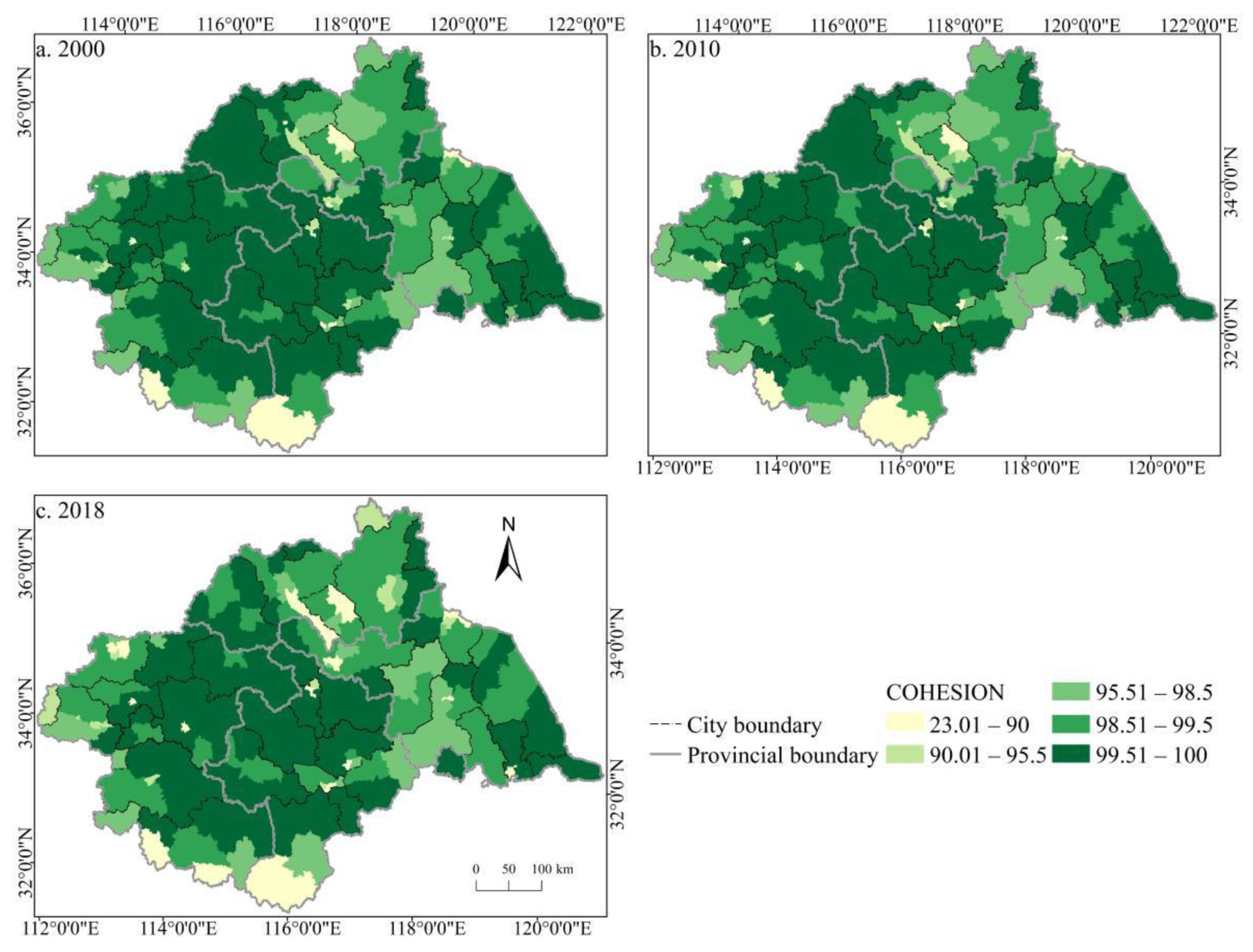

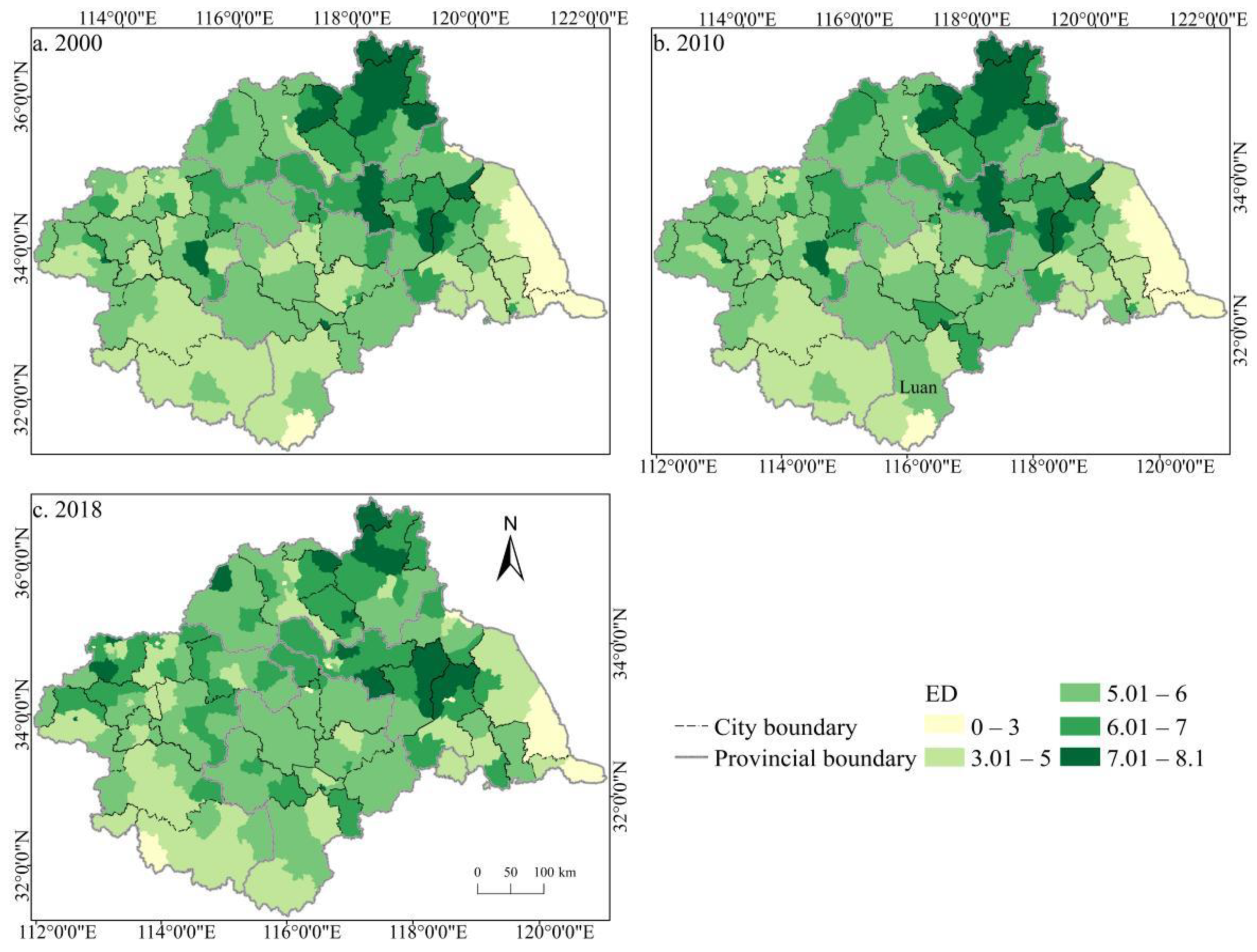

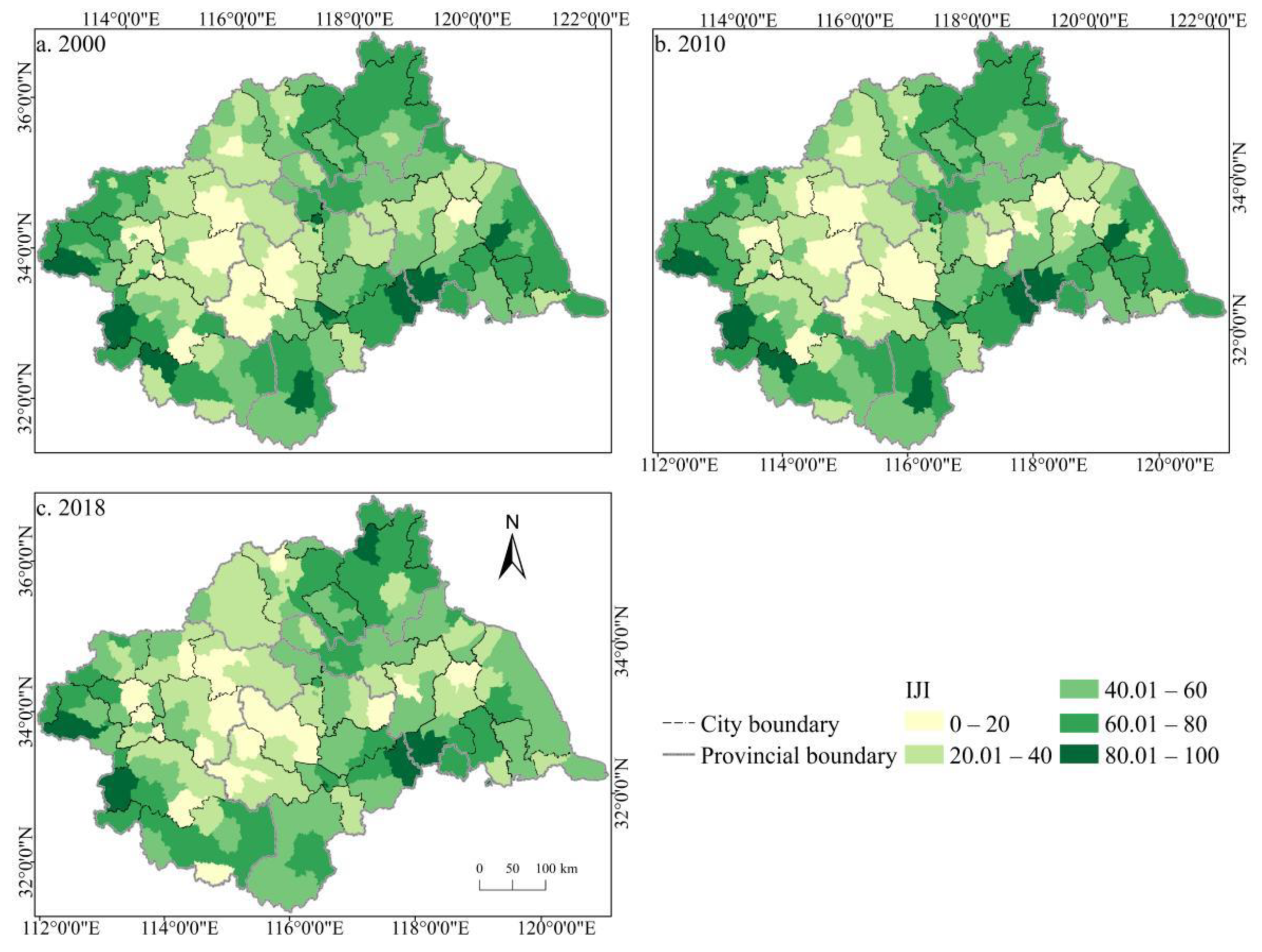
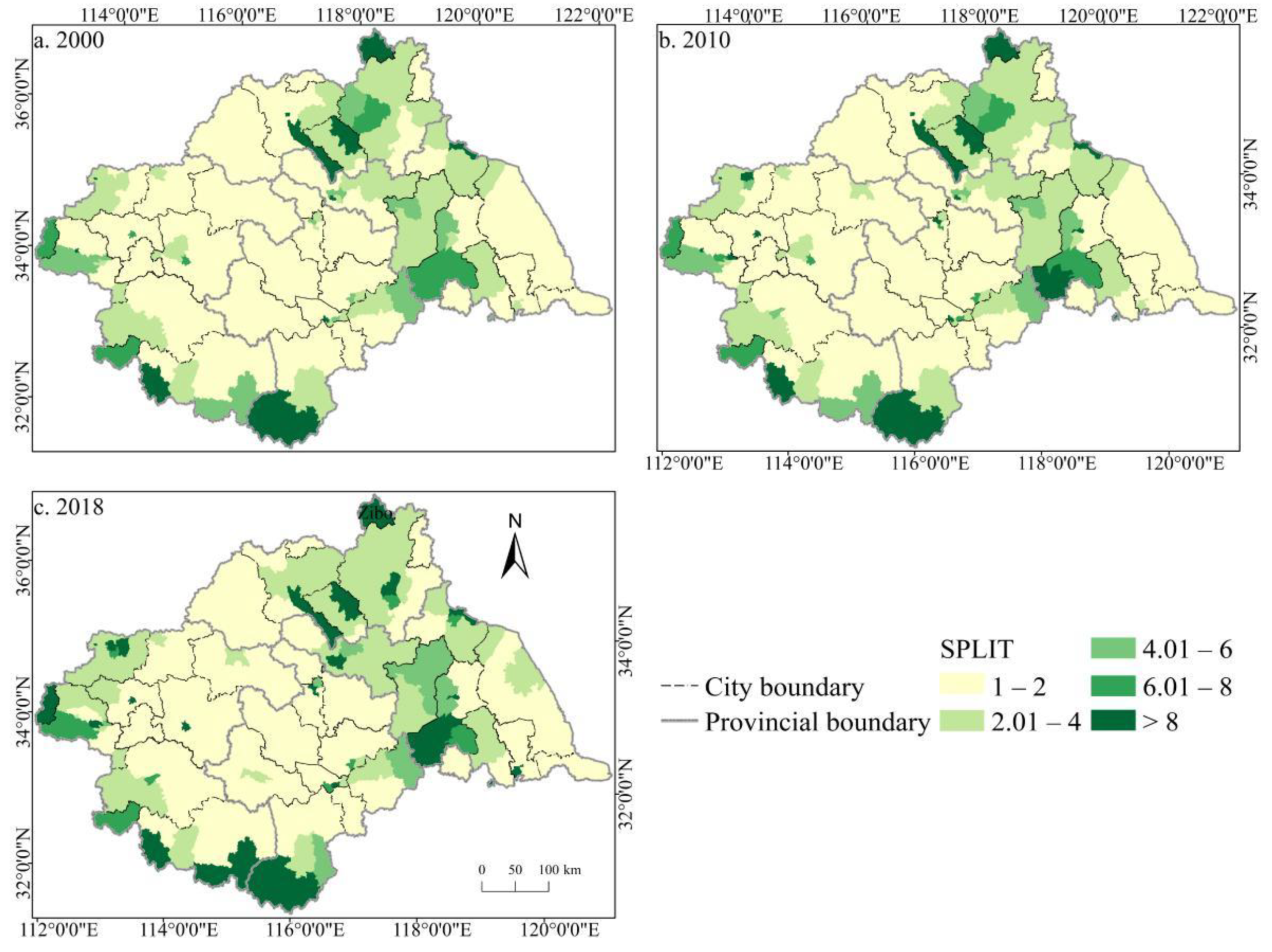
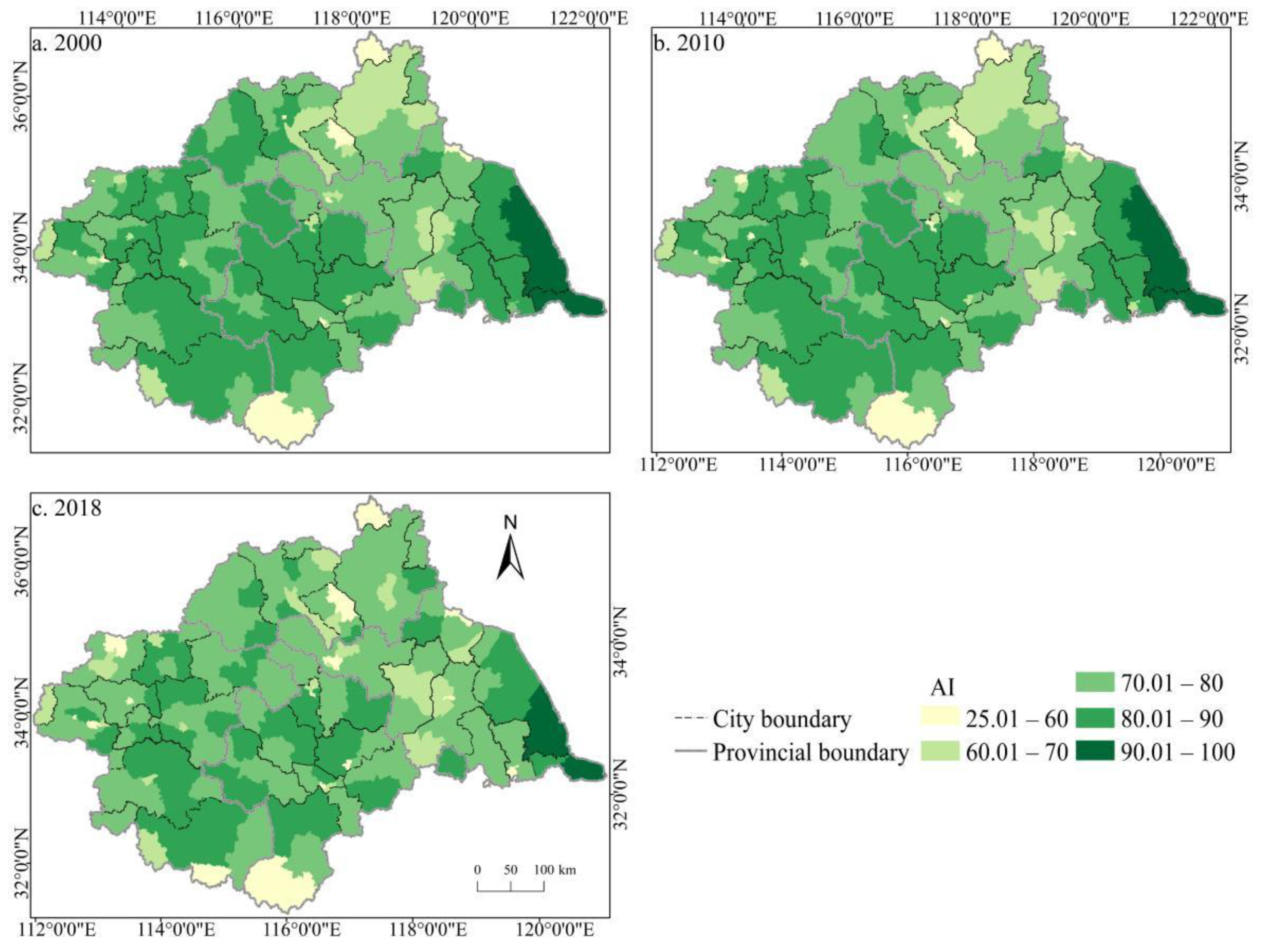
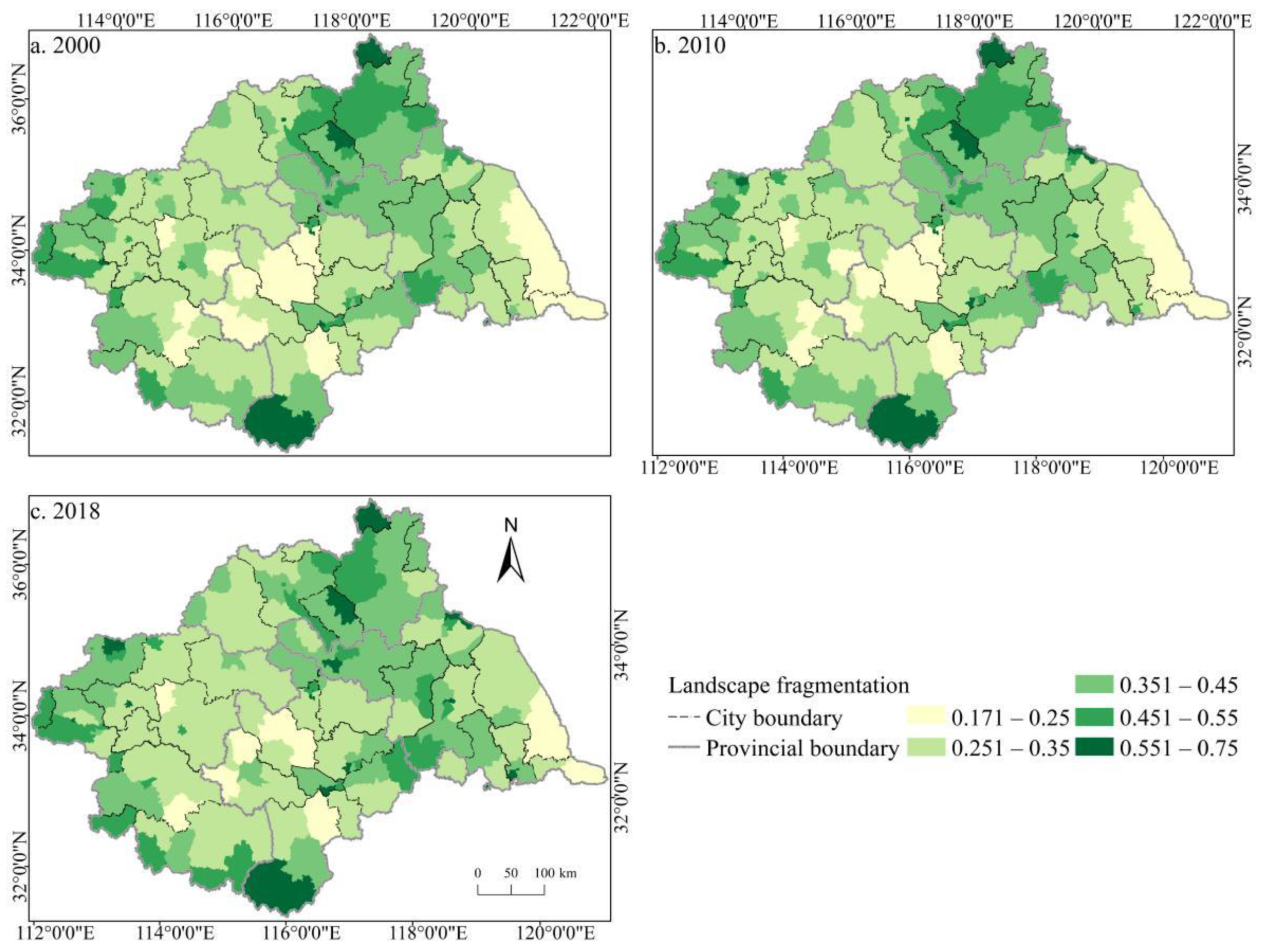
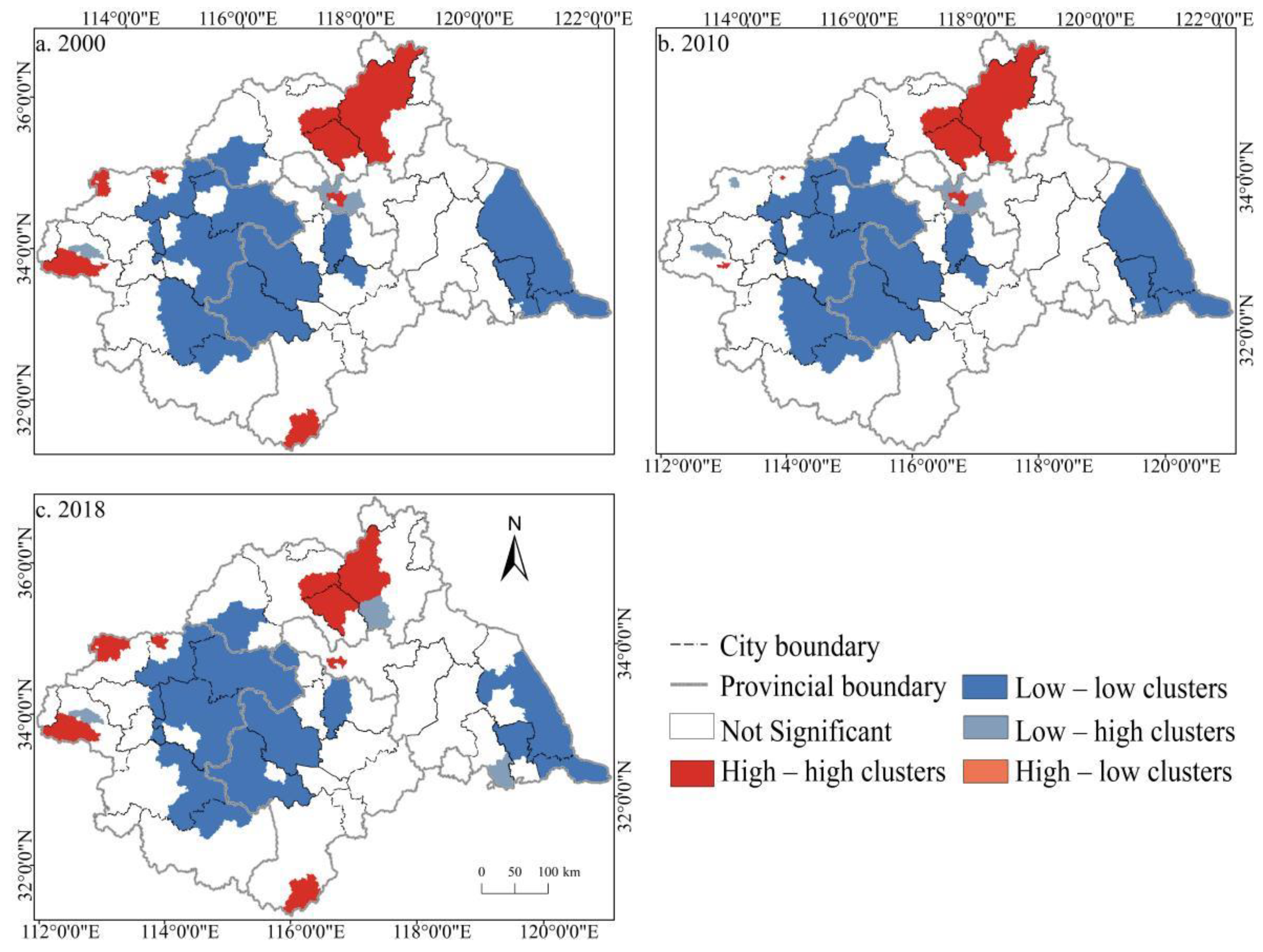
| Metrics | PLAND | PD | ED | AREA_AM | SHAPE_AM |
|---|---|---|---|---|---|
| VIF | 7.473 | 4.433 | 5.750 | 7.131 | 18.309 |
| Metrics | FRAC_AM | IJI | COHESION | SPLIT | AI |
| VIF | 11.263 | 1.223 | 5.409 | 1.823 | 9.625 |
| Aspects | Landscape Pattern Index | Calculation Formula | Description of Index |
|---|---|---|---|
| Size | Percentage of landscape (PLAND) | where aij is the area of patch ij; LA is the total landscape area of the study area. | PLAND indicates the area of a certain patch type accounts for the percentage of the total landscape area, and the value tends to be 0. The scarcer the patch type, the more fragmented the landscape pattern. |
| Patch density (PD) | where m is the total number of landscape types; LA is the total landscape area of the study area; Ni is the patch number of landscape i. | PD indicates the degree of influence of the patch boundary of the landscape type on the entire landscape. The larger the value, the more concentrated the patch type is distributed in the landscape. | |
| Edge—shape | Edge density (ED) | where Pij is the boundary length between type i and type j landscape element patches. | ED refers to the degree of landscape type segmentation by element boundary, which is a direct reflection of landscape fragmentation. The larger the value, the more fragmented the landscape pattern of this type of element. |
| Area-weighted mean patch area (AREA_AM) | where LA is the total landscape area of the study area; NP is the number of patches in the landscape. | AREA_AM reflects the degree of fragmentation of a certain type of landscape in landscape structure analysis. The higher the value, the lower the degree of fragmentation. | |
| Aggregation | Interspersion and juxtaposition index (IJI) | where Eij is the adjacent edge length between the type i and the type j of feature patch; m is the total number of landscape types; E is the edge length of the whole landscape. | IJI refers to the adjacent probability between certain patch element and other patches. The higher the value, the more adjacent other patch types, and the more fragmented the landscape of this type. |
| Patch cohesion index (COHESION) | where Pij represents the perimeter of patch i of landscape type j; aij represents the area of patch i of landscape type j; Z represents the number of patches in the landscape. | COHESION indicates the degree of agglomeration between different types of patches, the larger the value, the higher the degree of combination between dominant types of patches, and the lower the degree of fragmentation of this type of landscape. | |
| Splitting index (SPLIT) | where LA is the total landscape area of the study area; aij is the area of patch j of landscape type i; n is the number of patches of landscape type. | SPLIT refers to the degree of separation of landscape element. The larger the value is, the more dispersed among the same patch types and the higher the degree of fragmentation. | |
| Aggregation index (AI) | where gij is the number of similar adjacent patches of the landscape patch type | AI refers to the degree of agglomeration between patches of a certain type of landscape element. The larger the value, the more agglomerated patches of this type of element and the lower the degree of fragmentation. |
| Driving Factors | Classification Method | Level | Level Description |
|---|---|---|---|
| Altitude | NaturalBreaks | 1–6 | Calculation with Arc Toolbox/Spatial Analyst Tools/Reclass of ArcGIS10.3 |
| Slope | NaturalBreaks | 1–6 | 1. 0~5; 2. 6~10; 3. 11~15; 4. 16~20; 5. 21~25; 6. >25 |
| Distance to river | NaturalBreaks | 1–5 | Calculation with Arc Toolbox/Spatial Analyst Tools/Reclass of ArcGIS10.3 |
| NDVI | Zhang et al. [46] | 1–5 | 1. ≤0.2; 2. 0.2~0.4; 3. 0.4~0.6; 4. 0.6~0.8; 5. 0.8~1 |
| Average annual precipitation | NaturalBreaks | 1–5 | Calculation with Arc Toolbox/Spatial Analyst Tools/Reclass of ArcGIS10.3 |
| Per capita cultivated land area | NaturalBreaks | 1–5 | Calculation with Arc Toolbox/Spatial Analyst Tools/Reclass of ArcGIS10.3 |
| Intensity of human activities | Li et al. [47] | 0–10 | 0. sparse woodland, shrub, sparse grass, barren land; 1. river, reservoir, ponds, tidal flat, natural and plantation forest land, Moderate grass; 2. other woodland, dense grass; 7. cultivated land; 8. rural settlements; 9. industrial land; 10. Urban built-up |
| Population density | Ge et al. [48] | 1–5 | 1. 0~60; 2. 61~150; 3. 151~300; 4. 301~500; 5. >500 |
| Distance from road network | NaturalBreaks | 1–5 | Calculation with Arc Toolbox/Spatial Analyst Tools/Reclass of ArcGIS10.3 |
| Landscape Index | PLAND (#/100 ha) | PD (m/km2) | ED | AREA_AM (ha) | IJI (%) | COHESION | SPLIT | AI (%) |
|---|---|---|---|---|---|---|---|---|
| 2000 | 69.236 | 0.009 | 5.350 | 83,991.047 | 49.444 | 97.346 | 10.220 | 76.025 |
| 2010 | 67.495 | 0.010 | 5.410 | 82,716.491 | 48.591 | 96.792 | 12.562 | 75.257 |
| 2018 | 63.603 | 0.011 | 5.357 | 79,706.491 | 46.155 | 93.374 | 17.511 | 73.439 |
| Year | X1 | X2 | X3 | X4 | X5 | X6 | X7 | X8 | X9 |
|---|---|---|---|---|---|---|---|---|---|
| 2000 | 0.182 | 0.163 | 0.147 | 0.512 | 0.063 | 0.384 | 0.376 | 0.150 | 0.151 |
| 2010 | 0.169 | 0.159 | 0.165 | 0.406 | 0.096 | 0.424 | 0.378 | 0.259 | 0.141 |
| 2018 | 0.186 | 0.169 | 0.141 | 0.381 | 0.143 | 0.408 | 0.433 | 0.237 | 0.144 |
| 2000 | 2010 | 2018 | |||
|---|---|---|---|---|---|
| Interaction Factors | Interaction Intensity | Interaction Factors | Interaction Intensity | Interaction Factors | Interaction Intensity |
| X3∩X4 | 0.555 * | X1∩X4 | 0.532 * | X5∩X4 | 0.544 # |
| X5∩X4 | 0.567 * | X8∩X4 | 0.570 * | X5∩X7 | 0.558 # |
| X8∩X4 | 0.585 * | X6∩X4 | 0.580 * | X8∩X7 | 0.571 * |
| X8∩X6 | 0.588 # | X5∩X4 | 0.582 # | X8∩X6 | 0.579 * |
| X1∩X6 | 0.590 # | X8∩X7 | 0.594 * | X1∩X4 | 0.604 # |
| X1∩X4 | 0.594 * | X7∩X4 | 0.602 * | X1∩X6 | 0.608 # |
| X6∩X4 | 0.596 * | X2∩X6 | 0.609 # | X2∩X4 | 0.609 # |
| X2∩X6 | 0.598 # | X8∩X6 | 0.618 * | X2∩X6 | 0.612 # |
| X2∩X4 | 0.619 * | X1∩X6 | 0.627 # | X7∩X4 | 0.674 * |
| X7∩X4 | 0.677 * | X7∩X6 | 0.729 * | X7∩X6 | 0.722 * |
Publisher’s Note: MDPI stays neutral with regard to jurisdictional claims in published maps and institutional affiliations. |
© 2021 by the authors. Licensee MDPI, Basel, Switzerland. This article is an open access article distributed under the terms and conditions of the Creative Commons Attribution (CC BY) license (https://creativecommons.org/licenses/by/4.0/).
Share and Cite
Liang, J.; Pan, S.; Chen, W.; Li, J.; Zhou, T. Cultivated Land Fragmentation and Its Influencing Factors Detection: A Case Study in Huaihe River Basin, China. Int. J. Environ. Res. Public Health 2022, 19, 138. https://doi.org/10.3390/ijerph19010138
Liang J, Pan S, Chen W, Li J, Zhou T. Cultivated Land Fragmentation and Its Influencing Factors Detection: A Case Study in Huaihe River Basin, China. International Journal of Environmental Research and Public Health. 2022; 19(1):138. https://doi.org/10.3390/ijerph19010138
Chicago/Turabian StyleLiang, Jiale, Sipei Pan, Wanxu Chen, Jiangfeng Li, and Ting Zhou. 2022. "Cultivated Land Fragmentation and Its Influencing Factors Detection: A Case Study in Huaihe River Basin, China" International Journal of Environmental Research and Public Health 19, no. 1: 138. https://doi.org/10.3390/ijerph19010138
APA StyleLiang, J., Pan, S., Chen, W., Li, J., & Zhou, T. (2022). Cultivated Land Fragmentation and Its Influencing Factors Detection: A Case Study in Huaihe River Basin, China. International Journal of Environmental Research and Public Health, 19(1), 138. https://doi.org/10.3390/ijerph19010138







